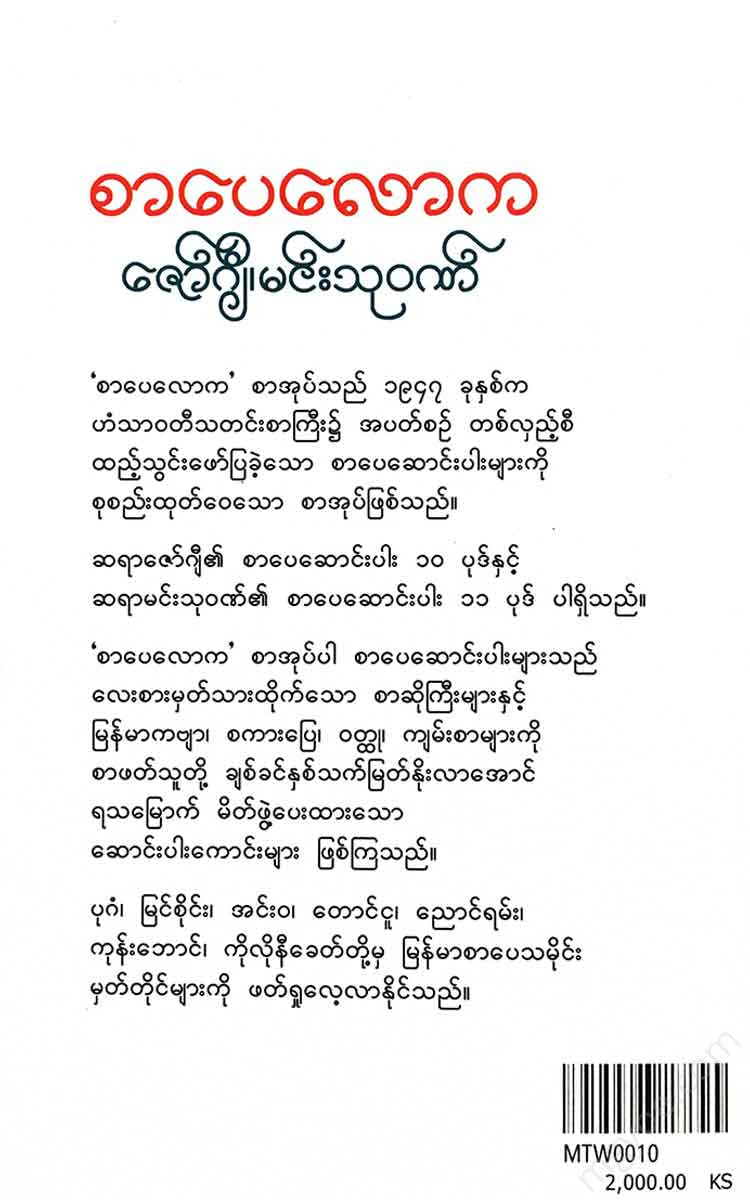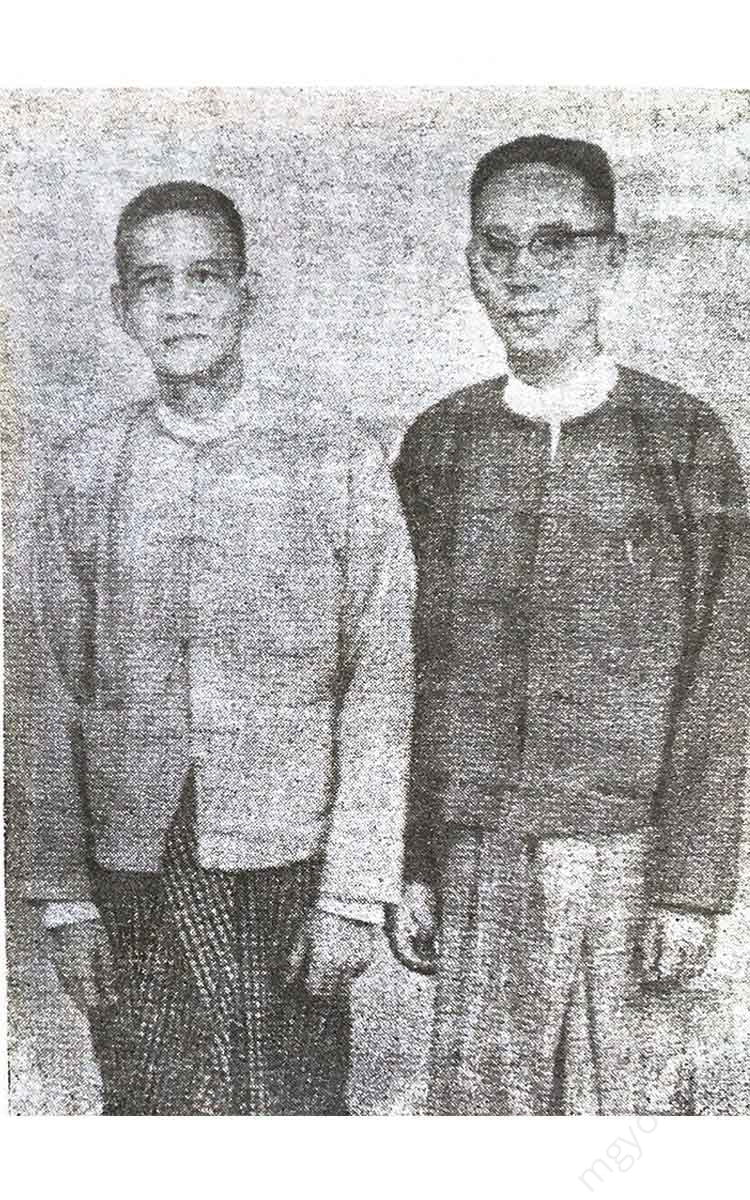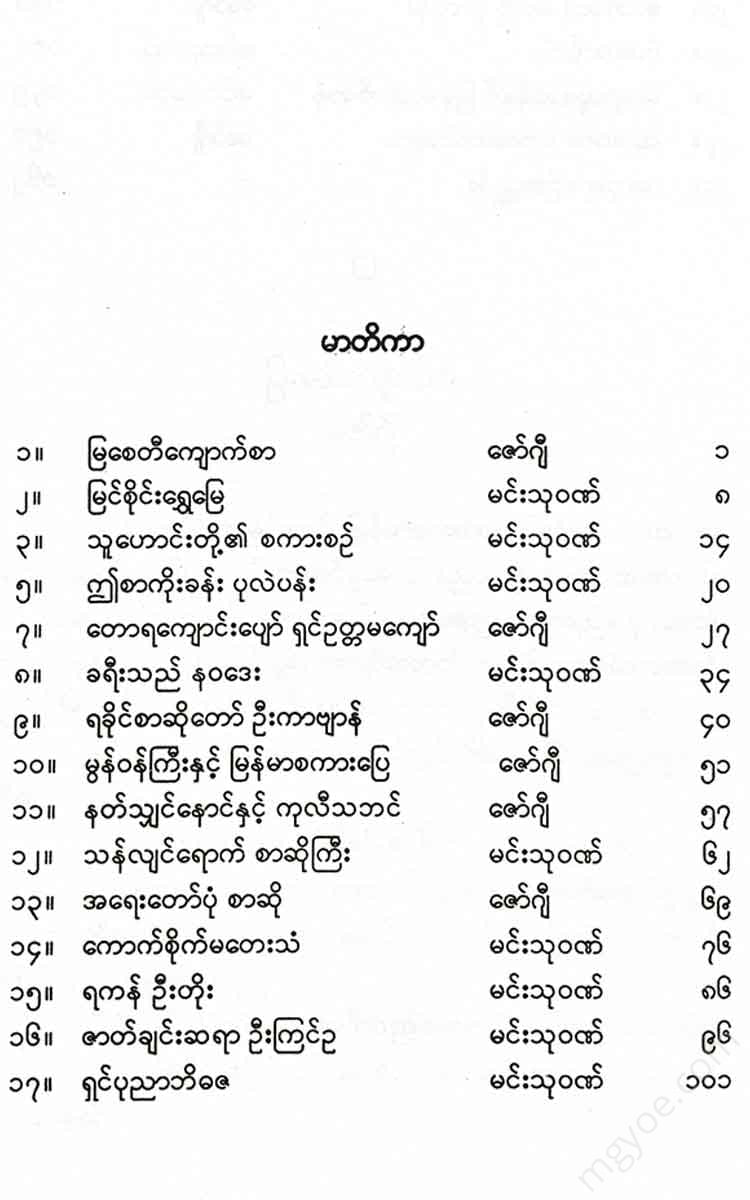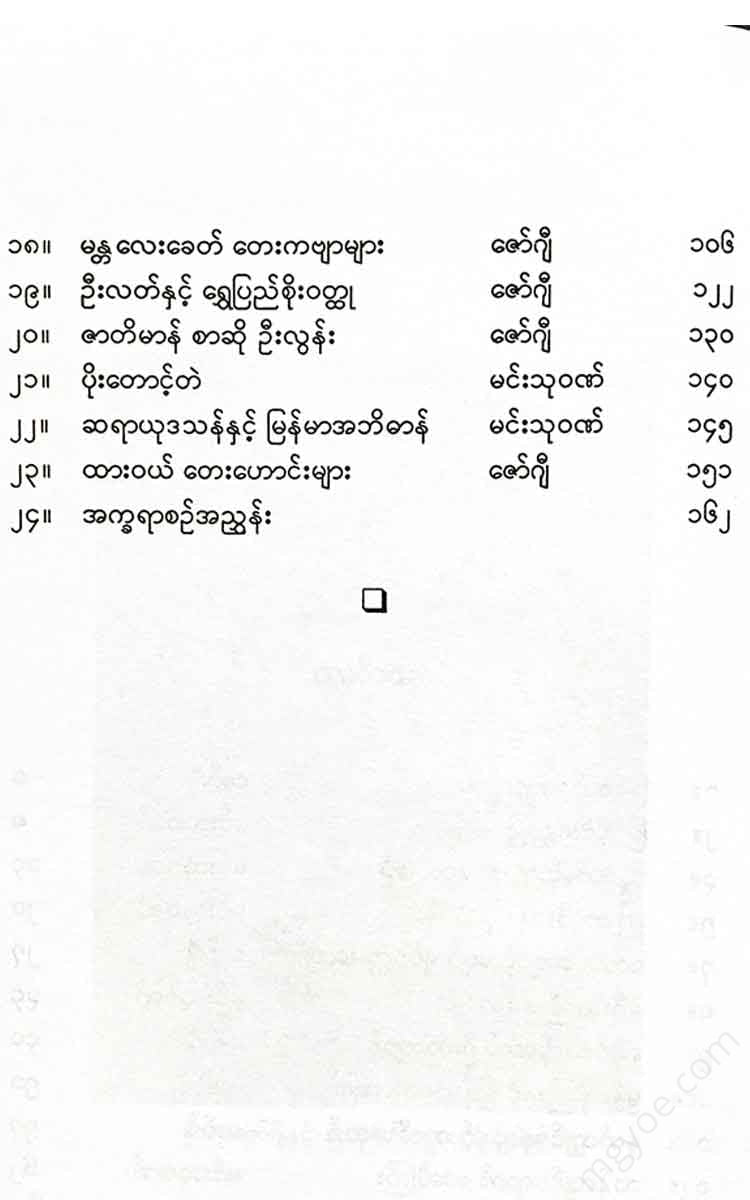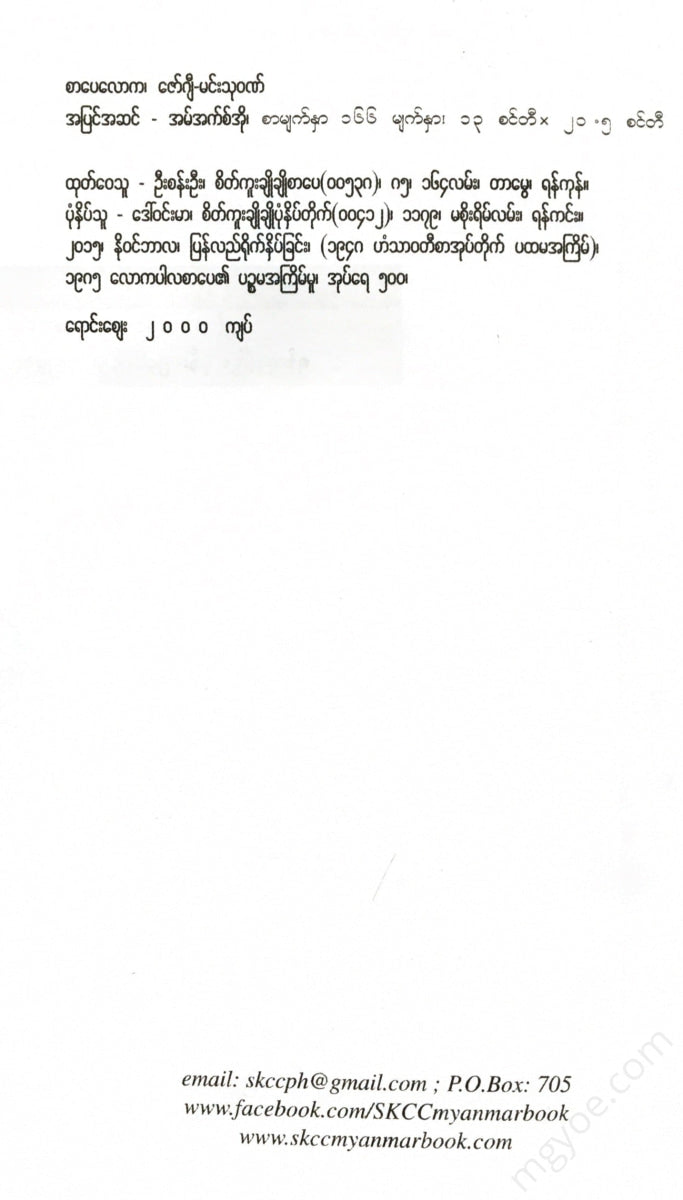စိတ်ကူးချိုချိုစာပေ
Zawji, Min Thuwan - Literary World
Zawji, Min Thuwan - Literary World
Couldn't load pickup availability
Emerald Stone Inscription
Zawgyi
In the history of Burmese literature, Burmese literature is divided into six periods: the Bagan period, the Pinya period, the Inwa period, the Taungoo period, the Nyaungran period, and the Alaungpagod period. The Bagan period is a period that flourished more than eight hundred years ago, and the Myazedi inscription is an inscription from that Bagan period.
When Bagan was prosperous, there were 999999999 houses in Bagan.
"Ninety-nine-ton Bagan houses"
Each ward has a gong that is used to sound for secular, religious, and criminal matters, so there are 3,333 wards in total.
"The dark,
There are 4,446,733 pagodas and temples in Bagan alone.
There is also a saying, “The sound of the cart’s axle is like the sound of the Bagan pagoda.” These words are a flattering description of the land of Bagan, which is considered to be a miracle. However, the ancient land of Bagan was indeed great. It is also true that it was magnificent.
Now, around the old city of Bagan on the east bank of the Ayeyarwady River, you can see many remaining pagodas and temples. These pagodas and temples bear witness to the greatness of Bagan. In addition, in these pagodas and temples, you can see mysterious sculptures, statues of the Chu Pan Chu family, and mysterious paintings. These mysterious decorations bear witness to the splendor of Bagan.
Along with so many and so mysterious pagodas and temples, you can also see stone inscriptions. When the ancient Pagan monks performed good deeds such as erecting pagodas or building temples, they would leave their offerings, prayers, and curses on stone pillars.
They are recorded on stone tablets. Stone inscriptions are those records.
Again, some meritorious people also include the reasons and events for their donations. The Mya Zedi Stone inscription is one such record.
The Myazedi inscription is believed to have been inscribed either in the year of the death of King Kyansittha or in the following year, 475 Burmese calendar. The Myazedi inscription has four faces, each face of which is written in a different language. The languages are Pali, Mon, Pyu, and Burmese. The shape of the letters is not circular, but rather like tamarind seeds. Myazedi
It is called the stone inscription because the stone inscription was found near the Mya Zedi Pagoda in Myin Ka Pa village, south of Bagan.
Rajakumar was the one who carved the Myazedi stone inscription. His native village was Kyaung Phyu. His father was King Kyan Sittha and his mother was his queen, Sang Lok U Sot Pan.
During the reign of King Anawrahta, King Kyan Sittha was living in a lowly household and was shunned by the king. While hiding, he met Sambula, a beautiful woman, and he spent his life with her. When King Anawrahta passed away and King Saw Lu ascended the throne, King Kyan Sittha saw Sambula, who had already conceived Rajakumar in her womb, and gave birth to a son, and he said, "Come to Bagan," and he became King Saw Lu's successor. When King Saw Lu passed away, King Kyan Sittha took the throne in 446 and received the title of "Siri Tri Nadi Dhammara".
When the second year of his reign as the remaining king was over, Rajakumar came to the king with his mother Sambula. The king, remembering Sambula's kindness, gave Sambula three years of life.
She was crowned as the goddess of the three worlds, Vatsaka Devi, who was adorned with a beautiful flower, and then made queen.
Rajakumara, who was late in coming, was given the title of Zeya Kshetra and was given only the Dhanyavadi and the seven districts of Taungam. This was because the king had anointed his grandson Alaungsithu and elevated him to the throne.
Later, his mother died. Then, in the year 474, his father, King Kyansittha, fell ill and passed away in the same year.
Rajakumar also dedicated a golden statue of the Buddha at the place where the horse was born and built a golden-topped cave. He also donated three villages of his inheritance to protect and worship the cave. Then, recalling the past and present of his parents, he wrote a record and erected a stone pillar.
Thus, the record of Rajakumar, known as the Emerald Stone Inscription, was left behind.
Rajakumara was a son who loved his mother and father and knew the infinite blessings. In his father's amazement, Rajakumara also remembered the things his father had given him. He also remembered the things he had received from his mother. Rajakumara could now freely use those things for himself. However, Rajakumara's wish was not that. It was only for his grateful father. He wanted to console his dying father and bring him to Nibbana.
Therefore, Rajakumara gave a golden statue of the Buddha that he had cast to his dying father. In return, he promised his father that he would donate three villages of his slaves to the golden statue.
Rajakumar remembered that incident and wrote in his stone inscription,
.....................
Sri.. Namo Buddhaya, one thousand six hundred and twenty-eight years after the passing of the divine religion, in this land called Arimaddanapura, there lived a king named Sri Trinita Nadi Dharmaraja. One of his concubines was Triloka Vatsaka Devi. That illegitimate son was also named Rajakumara. That king gave his illegitimate wife three slaves. When that illegitimate wife died, that illegitimate wife and her three slaves were supported by that illegitimate son, Rajakumara. That king ruled for twenty-eight years and died in Nasara. Remembering the merit of the king who had given birth to him, the golden-faced God descended and bowed down to him. Thus he said. "This golden Buddha is for my master, my servant. The three villages of slaves, my servant, my master gave to this golden Buddha, my servant gave to me."
It was recorded.
Thus speaking, Prince Rajakumara handed over the golden statue of the Buddha to the dying king. He also promised, "I will give you three villages of slaves."
The king, who was suffering, saw his son's body. He received the golden image of the Buddha from his son's hand. He heard his son's promise again. What would happen to the king's mind? What would the king say?
Even in ordinary times, parents who see the behavior of their children who love and know their infinite grace are filled with joy and happiness. Even in the midst of death,
What is the possibility? Does the king want a deity? It is like a dream. Does he want Brahma? It is like a dream. Does he want Nibbana? It is like a dream.
Rajakumara, who loved the king, seemed to have seen the colors and forms of the king, who was so excited with joy that the ordinary eye could not see. He seemed to remember how he had suddenly become happy. He seemed to remember how he had suddenly become sad and heartbroken.
Therefore, Rajakumara pretended to hear that his father, the king, was pleased and invited him to offer alms, and pretended to see that his father, the king, himself, poured water on the golden image of the Buddha in front of the monks.
Then the king of the two kings said, “Good, good,” and poured water in the presence of the venerable Thera,
He continued to write..
Then, Rajakumara continued with the following prayer and curse, describing how he built his cave temple, donated three villages to his servants, and...
" Then, Rajakumara, the son of a prostitute, worshipped the golden Buddha and built a cave with a golden peak. Having done this, in the cave, he took the village of Satmunalon, the village of Rape Tasha, the village of Ngahan Mai, and these three villages of slaves. Rajakumara, the son of a prostitute, poured water on this cave and said thus: This is my work, which will lead to the attainment of omniscience and knowledge. My descendants, my sons, my grandsons, my friends, and others, the only thing I have offered to this god is the Lord of the Universe.
"May you be blessed."
It ended.
The prose in the Myazedi Stone Inscription is arguably the oldest Burmese prose. The language used is different in some places from the present day. However, it should be noted that the present day language is mostly derived from ancient language.
"In the word 'pa', 'pa' is the same as the words 'ka', 'ka', 'ka', and 'ka' in the later expressions 'ka', 'ka', etc. "In the word 'na', 'na', 'na', from the ancient 'na', it means 'na'. When it is sick'. In the word 'na', it means 'to give with respect'. "It is in the meaning of 'to leave'.
In the word 'our servant', Rajakumar is said to be referring to himself alone, but he uses the plural form, saying "we ". Some people think that this is the meaning of the words "two-way
(See.. The Bagan Stone Inscriptions, compiled by U Pe Maung Tin and G.E. Lus.)

